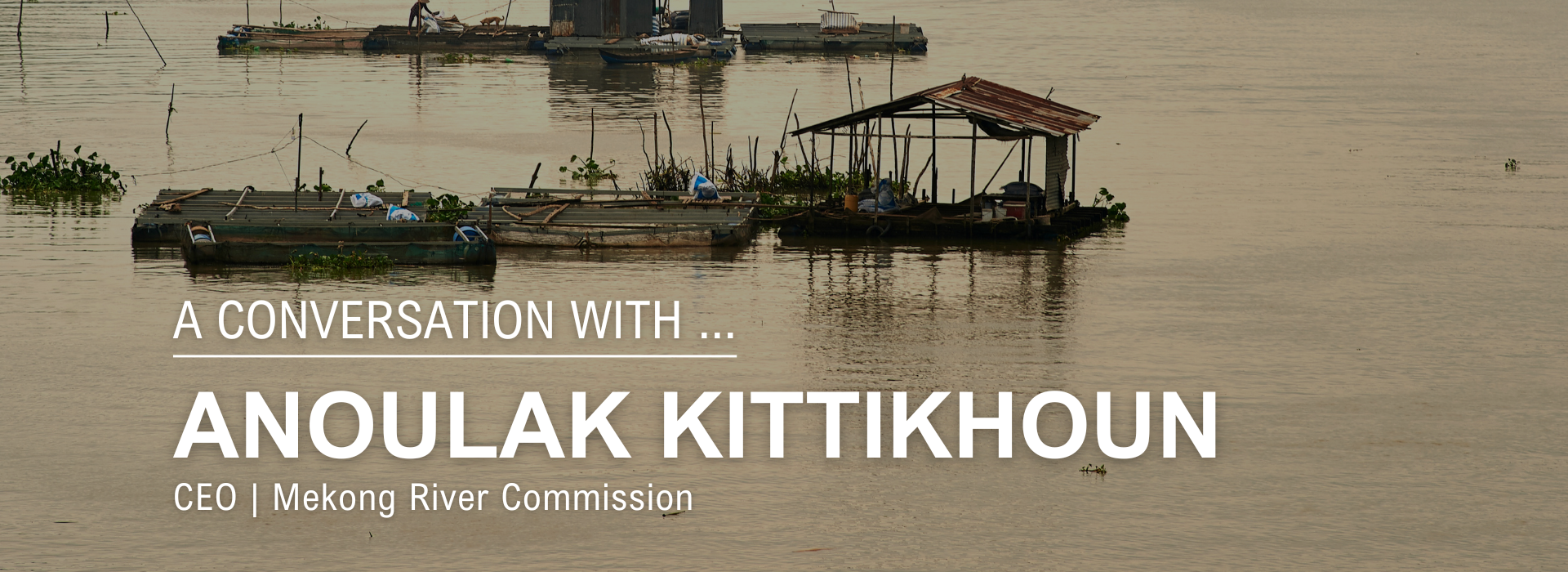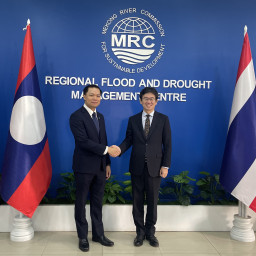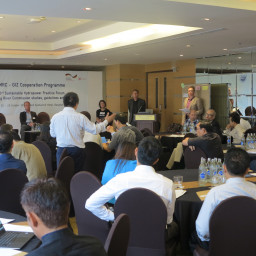A Conversation with Dr. Kittikoun, CEO of the Mekong River Commission Secretariat
Dr Kittikoun, CEO of the Mekong River Commission Secretariat, discusses the organisation's priorities, the changing landscape of the Mekong River & the future of water cooperation in the region
- Priorities by 2025 are to effectively monitor by upgrading DSF, forecast flood & drought more accurately, support countries to better plan projects & develop app for public use
- The Mekong River Basin seen rapid economic growth with water-related sectors contributing~ US$63bn & improved water, food & energy security over the past 2 decades
- But there are many challenges – climate change, equitable use & more; the Mekong must remain a symbol of peace, prosperity & friendship among its riparian nations
China Water Risk (CWR) sit down with Dr. Anoulak Kittikoun to discuss the organisation’s priorities, the changing landscape of the Mekong River & the future of water cooperation in the region. The Mekong River, a lifeline in South-East Asia, covers a distance of nearly 5,000 km from its source on the Tibetan Plateau in China to the Mekong Delta, flowing through six countries: China, Myanmar, Thailand, Lao PDR, Cambodia and Viet Nam. Today, the river is rapidly changing as economic development, urbanisation and industrialisation are transforming the basin. Without coordinated efforts, the future of the Mekong and the people & economies that depend on it are uncertain.
CWR: Thank you for talking with us. With your role at the Mekong River Commission (MRC) can you tell us about what the Commission does and what your priorities are?
The MRC is as an intergovernmental, river basin organization fostering collaboration among the four Member Countries – Cambodia, Lao PDR, Thailand, and Viet Nam – and seeks to balance water resources development and protection of the Mekong River and related resources. The MRC was established in 1995 by a treaty, but our Mekong cooperation actually dates back to 1957 when our predecessor Mekong Committee was established. We serve two key roles: water diplomacy platform and regional knowledge hub. We work actively with our two upper Mekong riparian countries – China and Myanmar, who are our Dialogue Partners.
In this strategic period that runs from 2021 to 2025, our foremost priorities are to ensure that we monitor the river effectively, forecast flood and drought more accurately, provide timely data and information, support the countries to plan better projects (hydropower, irrigation, navigation, fisheries, etc) with more benefits and less negative impacts, and facilitate dialogue and cooperation on all transboundary issues with the support of partners and stakeholders. Here, we are doing a few things.
First, we are enhancing our decision support framework so that our member countries are equipped with data and tools for better monitoring and preparedness. Our upgraded Decision Support Framework (DSF) will contain an interactive dashboard on the conditions of the river, and dam operation and future change of climate, land use and other related infrastructure development on water quality and quantity.
At the same time, we are fostering the sharing of data from water infrastructure projects, including hydropower, among the riparian countries. By providing and receiving accurate, up-to-date information, decision makers and the public will be better prepared to address issues timely and effectively, such as changes in flows and water levels in the Mekong. Linking to that, we have started developing an MRC app, which will allow the public to better access these data in the palms of their hands.
Second, with changes in the natural flow regime of the Mekong, driven by rapid development, increasing water-related emergencies, and climate change, we need to be more proactive in terms of planning from a basin perspective among the Mekong Basin countries to enhance their national plans and projects, thereby improving water security and building climate resilience. With China and Myanmar under the Lancang-Mekong Cooperation, we continue to conduct the Joint Study phase 2, following the completion of phase 1 last year. The focus of phase 2 is on assessing future trends and developing adaptation measures including additional storage capacity, or enhancing and protecting existing storage, alongside exploring non-infrastructural solutions such as better coordination of water infrastructures.
Concurrently, in the context of environmental challenges in the basin, especially reduced wild fisheries and the potential impact on livelihoods, we are preparing to launch transboundary fish projects to stabilize fish stocks in the Lower Mekong River Basin. Equally important, we are establishing a funding mechanism called the Mekong Fund to provide both direct and indirect aid to communities significantly impacted by climate change-induced drought, flooding, and the negative consequences of water infrastructure development.
This year, we will continue to capitalize on our cooperation with ASEAN by strengthening our ties with the region. We will be holding the 2nd ASEAN-MRC Water Security Dialogue in the lead up to the ASEAN Summits that Lao PDR is hosting. It will bring together ASEAN officials and experts to examine innovative solutions to address the multifaceted challenges of water security across the region – water pollution, water scarcity and drought, as well as water disasters such as floods and storms. Bringing ASEAN and MRC together put increasing recognition of the importance of the Mekong to ASEAN integration and solidarity.
CWR: What changes have there have been along the Mekong over the last decade?
Based on our studies, summarized in the State of the Basin Report 2023, we have observed quite a number of changes in the Mekong River system. For example, economic growth has been rapid across the basin, fueled by developments in water and related sectors bringing economic benefits and poverty reduction. Taken together, Cambodia, Lao PDR, Thailand, and Viet Nam represent around half the Mekong region’s entire production of rice and fish, a third of its tourism, and a large percentage of the region’s energy demands. Various sectors reliant on water resources have contributed to robust economic performance, with an estimated total annual economic value of approximately USD 63 billion. Hydropower, rice production, and tourism have seen significant growth, particularly in countries like Cambodia and Lao PDR. Moreover, aquaculture and navigation activities in the Mekong Delta have experienced rapid expansion, further bolstering the economic landscape of the region.
In terms of social conditions, all countries within the basin have made considerable strides in enhancing living standards, well-being, and livelihoods. The communities within the basin have experienced improved water, food, and energy security over the past two decades. Access to safe water for drinking and agriculture, basic sanitation facilities, and electricity has increased across the board. Food availability has risen, leading to decreased rates of malnutrition and water-related diseases.
Nevertheless, the Mekong River Basin has experienced a permanent modification of mainstream flow regime, the substantial reduction in sediment flows due to sediment trapping, the continuing loss of wetlands, the deterioration of riverine habitats, and the growing pressures on capture fisheries. Dry season flows have increased while flood season flows have decreased compared to previous years. This alteration is evident throughout the length of the river, with the most pronounced impacts observed in the upper basin areas. The overall volumetric impact is particularly significant downstream of the Mekong River Basin, likely due to the combined effects of basin-wide development projects and recent climatic variations, notably decreased annual precipitation.
Addressing these challenges is not an easy task. It demands a political commitment of the highest order. It will require active cooperation from all Mekong riparian countries, through the MRC, working with all partners, and engagement from all stakeholders. Luckily, the Mekong countries have well established cooperation mechanism such as the MRC, and clear strategy in place in the Basin Development Strategy, a blueprint strategy that harmonizes national interests and optimizes regional benefits, as well as promotes shared development responsibility among the countries.
CWR: Managing transboundary water can be difficult but mechanisms between countries can help. One such is the Lancang-Mekong Cooperation Mechanism launched in 2016 between China, Cambodia, Laos, Myanmar, Vietnam and Thailand. Can you tell us about it? What successes and challenges have there been? Can it be a model for others?
The LMC mechanism brings the 6 Lancang-Mekong countries together in many fields of cooperation, one of which is water cooperation. The MRC and its member countries work closely with LMC, including through an MoU with the LMC Water Center which underscores the commitment of both entities to collaborate in good faith in addressing water-related challenges in the Mekong. Furthermore, the active participation of the MRC in Joint Working Group (JWG) meetings within the framework of LMC water cooperation signifies a synergistic approach towards achieving common goals. Joint studies, institutional linkages, and collaborative efforts such as the upcoming Joint Expert Group and Joint Lancang-Mekong Survey further solidify the cooperative spirit among member countries. This has fueled and uplifted the cooperation between the MRC, Mekong countries and China for the regional common good.
CWR: What do you think will happen in the next 5, 10 and 20 years along the Mekong and with managing transboundary water in the region?
Climate change is the most crucial challenge we face today, and we’re currently in a critical moment. The effects of climate change, such as changing weather patterns affecting food production and rising water levels escalating the danger of severe floods, are threatening the Mekong River and the livelihood of the Mekong communities. Challenges in equitable and sustainable use of the Mekong water and its resources are another issue. They may continue to increase as they are fueled by the changing climate. However, despite these challenges, the Mekong River is a resilient waterway, capable of adaptation and sustainable development with the strong cooperation of its riparian nations.
Looking ahead, we can anticipate continued efforts by Member Countries of the MRC and the LMC mechanism to enhance cooperation and coordination in managing water resources. This collaboration will involve data sharing, joint projects, and basin-wide initiatives aimed at addressing water security concerns, mitigating the impacts of floods and droughts, and promoting sustainable development. Riparian countries shall continue to empower the MRC and major powers must cooperate for the sake of the Mekong. In the long term, spanning the next 20 years and beyond, the Mekong River Basin must remain a symbol of peace, prosperity, and friendship among its riparian nations. Through continued support from international partners and stakeholders, the region can harness Mekong's vast resources sustainably, fostering economic growth, social development, and environmental stewardship.
CWR: What piece of advice would you give to governments/ investors and/or businesses to solve these issues?
To effectively manage transboundary water resources in the Mekong region, it is important to prioritize adherence to the strategies, plans, procedures, and guidelines outlined in our Basin Development Strategy 2021-2030. Our comprehensive strategies and guidelines offer a structured approach to tackling multifaceted water-related challenges, furnishing a clear pathway for collaborative action among member countries. There is no need for disputes. With the one Mekong, one spirit, we can work together to address any issues large or small. By adhering to these established protocols, governments can enhance transparency, accountability, and stakeholder engagement in their decision-making processes. Simultaneously, the private sector can mitigate risks associated with water management projects and increase their reputation by following MRC procedures and guidelines.
###




